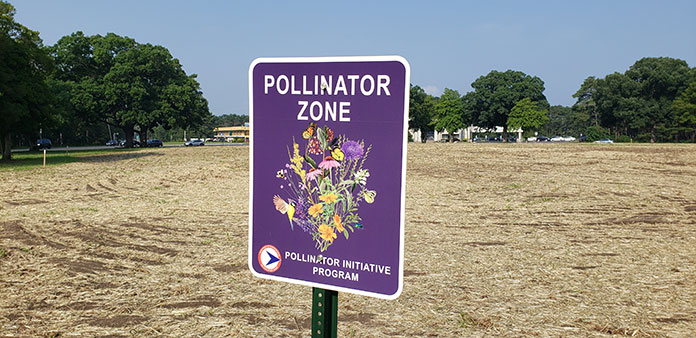
LAKEHURST – The field inside one of the borough’s traffic circles doesn’t look quite the same these days. If you can catch the signs as you drive past, you’ll notice they say “Pollinator Zone.”
Borough officials and residents weren’t aware the area had received this designation until they saw the signs put up by the New Jersey Department of Transportation (NJDOT) earlier this summer as part of that agency’s Pollinator Habitat program.
“We didn’t have any problem with it but we weren’t made aware of it by the state until we saw the signs ourselves,” Lakehurst Mayor Harry Robbins told The Manchester Times.
NJDOT Communications/Public Information Officer Elizabeth Galamba told The Manchester Times, “The Lakehurst Circle Center was one of four pollinator habitats planted this summer along the Route 70 Corridor.”
“The other habitats are located at Route 70/Route 37 Circle, Red Lion Circle by the NJDOT Red Lion Maintenance Yard, and Four Mile Circle. All areas were seeded with native species best suitable for the location, as part of the NJDOT Pollinator Initiative,” she added.
Galamba said, “this initiative was established in 2020 by the Department’s Office of Landscape Architecture (OLA) in response to the global decline of pollinator species and their habitats. Since then, dozens of pollinator sites have been established across the state on NJDOT rights-of-way.”
“Additionally, the Department has installed identification markers and signage in existing milkweed areas to preserve and support New Jersey’s Monarch Butterfly population, which is close to being listed as an endangered species,” Galamba added.
Galamba said the “Lakehurst Pollinator Habitats were inspired by the Department’s initiative to minimize our carbon footprint, preserve the natural beauty of our state, and reduce mowing efforts, although mowing plans have been created for each area to maintain visibility for motorists.”
Typically, requests for pollinator habitats can be made directly to OLA or through the NJDOT Office of Community Relations, she added.
Build Your Own Pollinator Garden
For those interested in creating a pollinator garden, according to U.S. Fish and Wildlife Service representative Mara Koenig, “pollinators are the engine that run healthy habitats. While we’ve been actively working to restore and conserve millions of acres of land, we need your help.”
“Whether you have a few feet on your apartment balcony, a yard in need of landscaping or several acres, you can make a difference,” she added.
She explained that through a step-by-step guide citizens can build their own pollinator garden “and help ensure the future is filled with pollinators.”
Choosing your location: She said, “while flowering plants can grow in both shady and sunny locations, consider your audience. Butterflies and other pollinators like to bask in the sun and some of their favorite wildflowers grow best in full or partial sun with some protection from the wind.”
Identifying soil type and sunlight: “Take a look at your soil – is it sandy and well-drained or more clay-like and wet? You can turn over a test patch or check out the soil mapper for your county to learn more. Your soil type and the amount of sunlight it gets will help determine the kinds of plants you can grow,” Koenig added.
Choosing your plants: She advised researching which varieties of milkweed and wildflowers are native to your area and do well in your soil and sunlight conditions.
“Find a nursery that specializes in native plants near you – they’ll be familiar with plants that are meant to thrive in your part of the country. It’s essential to choose plants that have not been treated with pesticides, insecticides or neonicotinoids. You’ll also want to focus on selecting perennials to ensure your plants come back each year and don’t require a lot of maintenance.”
Seeds vs. plants: Koenig said, “once you’ve identified your plant species, you’ll need to decide whether to use seeds or start with small plants. While both are good options, your choice will depend on your timeline and budget. Seeds are more economical, especially for larger gardens, but will require more time. Nursery-started plants cost more, but will generally give you a quick return on your investment and bring pollinators into your yard during the same growing season.”
Wait, watch, water and weed: “It may take some time, but you will eventually see butterflies and other pollinators enjoying your garden. Make sure to weed and water your garden to keep it healthy,” she added.





